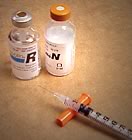
DIABETES
 Diabetes mellitus is a common condition in which the
amount of glucose (sugar) in the blood is too high because the body
is unable to use it properly. This is because the body's method of
converting glucose into energy is not working as it should. Diabetes mellitus is a common condition in which the
amount of glucose (sugar) in the blood is too high because the body
is unable to use it properly. This is because the body's method of
converting glucose into energy is not working as it should.
Normally, a hormone called insulin carefully controls the amount of glucose
in our blood. Insulin is made by a gland called the pancreas, which lies just
behind the stomach. It helps the glucose to enter the cells where it is used
as fuel by the body. We obtain glucose from the food that we eat, either from
sweet foods or from the digestion of starchy foods such as bread or potatoes.
The liver can also make glucose.
After a meal, the blood glucose level rises and insulin is released into the
blood. When the blood glucose level falls - for example, during physical activity
- the level of insulin falls. Insulin, therefore, plays a vital role in regulating
the level of blood glucose and, in particular, in stopping the blood glucose
from rising too high.
There are two main types of diabetes:
Type 1 Diabetes:
Also known as insulin dependent diabetes
Type 2 diabetes:
Also known as non-insulin dependent
diabetes
Type 1 diabetes develops when there
is no insulin in the body because the cells in the pancreas that
produce it have been destroyed. This type of diabetes usually
appears in people under the age of 40, often in childhood. It
is treated by insulin injections and diet.
Type 2 diabetes develops when the
body can still produce some insulin, though not enough for its
needs, or when the insulin that the body produces does not work
properly. This type of diabetes usually appears in people over
the age of 40. It is treated by diet and exercise alone, or by
a combination of diet and tablets, or in some instances by a combination
of diet and insulin injections.
What are the symptoms of diabetes?
The main symptoms of diabetes are:
| |
 |
 |
Increased thirst |
 |
Blurred vision |
 |
Frequent visits to the toilet
(especially at night) |
 |
Genital itching or regular bouts
of thrush |
 |
Weight loss |
 |
Extreme tiredness |
Type 2 diabetes develops
slowly and the symptoms are usually less pronounced. Some people may
not notice any symptoms at all and their diabetes is only picked up
in a routine medical check up. Some people may put the symptoms down
to 'getting older' or 'overwork'.
Type 1 diabetes develops much more
quickly, usually over a few weeks, and symptoms are normally very
obvious. In both types of diabetes, the symptoms are quickly relieved
once the diabetes is treated. Early treatment will also reduce the
chances of developing serious health problems.
Who gets diabetes and what
causes it?
Diabetes is a common health condition. About 1.4 million people in the UK are
known to have diabetes – that’s about three in every 100 people.
And there are an estimated one million people in the UK who have diabetes but
don't know it. Over three-quarters of people with diabetes have Type 2 diabetes.
Although the condition can occur at any age, it is less common in infants and
becomes more common as people get older.
Type 1 Diabetes
Type 1 diabetes develops when the insulin producing cells in the pancreas have
been destroyed. Nobody knows for sure why these cells have been damaged but
the most likely cause is an abnormal reaction of the body to the cells. This
may be triggered by a viral or other infection. This type of diabetes generally
affects younger people. Both sexes are affected equally.
Type 2 Diabetes
Type 2 diabetes used to be called 'maturity onset' diabetes because it usually
appears in middle-aged or elderly people, although it does occasionally appear
in younger people. The main causes are that the body no longer responds normally
to its own insulin, and/or that the body does not produce enough insulin.
People who are overweight are particularly likely to
develop Type 2 diabetes. It tends to run in families and is more common
in Asian and African-Caribbean communities. Some people wrongly describe
Type 2 diabetes as 'mild' diabetes. There is no such thing as mild
diabetes. All diabetes should be taken seriously and treated properly.
Other causes of diabetes
There are some other causes of diabetes, including certain diseases of the
pancreas, but they are all quite rare. Sometimes an accident or an illness
may reveal diabetes if it is already there, but they do not cause it.
How diabetes is treated?
Although diabetes cannot be cured, it can be treated very successfully. Knowing
why people with diabetes develop high blood glucose levels will help you to
understand how some of the treatments work.
Blood glucose levels
When sugar and starchy foods have been digested, they turn into glucose. If
somebody has diabetes, the glucose in their body is not turned into energy,
either because there is not enough insulin in their body, or because the insulin
that the body produces is not working properly. This causes the liver to make
more glucose than usual but the body still cannot turn the glucose into energy.
The body then breaks down its stores of fat and protein to try to release more
glucose but still this glucose cannot be turned into energy. This is why people
with untreated diabetes often feel tired and lose weight. The unused glucose
passes into the urine, which is why people with untreated diabetes pass large
amounts of urine and are extremely thirsty.
Treatment for Type 1 Diabetes
People with Type 1 diabetes need injections of insulin for the rest of their
lives and also need to eat a healthy diet that contains the right balance of
foods. Insulin cannot be taken by mouth because it is destroyed by the digestive
juices in the stomach. People with this type of diabetes commonly take either
two or four injections of insulin daily.
If you or someone close to you needs insulin injections, your doctor or diabetes
nurse will talk to you, show you how to do them and give you support and help.
They will also show you how you can do a simple blood or urine test at home
to measure your glucose levels. This will enable you to adjust your insulin
and diet according to your daily routine. Your doctor or diabetes nurse will
advise you what to do if your glucose level is too low.
If you have Type 1 diabetes, your insulin injections
are vital to keep you alive and you must have them every day.
Treatments for Type 2 diabetes
People with Type 2 diabetes need to eat a healthy diet that contains the right
balance of foods. If your doctor or diabetes nurse finds that this alone
is not enough to keep your blood glucose levels normal, you may also need
to take tablets.
Reducing the risk of serious
health problems
People with diabetes have a higher chance of developing certain serious health
problems, including heart disease, stroke, high blood pressure, circulation
problems, nerve damage, and damage to the kidneys and eyes. The risk is particularly
high for people with diabetes who are also very overweight, who smoke or who
are not physically active.
You will greatly reduce your risk of developing any of these complications
by controlling your blood glucose and blood pressure levels, and by eating
healthily and doing regular physical activity.
Regular medical check-ups
In the last 10 to 20 years, the care for people with diabetes has improved
dramatically. One of the most important developments has been improved methods
of screening which will help your doctor to pick up any health problems at
an early stage so they can be treated more successfully. This is why having
regular medical check-ups, at least annually, is so important. Maintaining
a sensible weight is a variable that can help reduce your chances of developing
diabetes. Check whether you have a healthy weight on our BMI
Calculator.
For further Information on diabetes contact
Diabetes UK on : Tel 020 7323 1531
|



 Diabetes mellitus is a common condition in which the
amount of glucose (sugar) in the blood is too high because the body
is unable to use it properly. This is because the body's method of
converting glucose into energy is not working as it should.
Diabetes mellitus is a common condition in which the
amount of glucose (sugar) in the blood is too high because the body
is unable to use it properly. This is because the body's method of
converting glucose into energy is not working as it should.